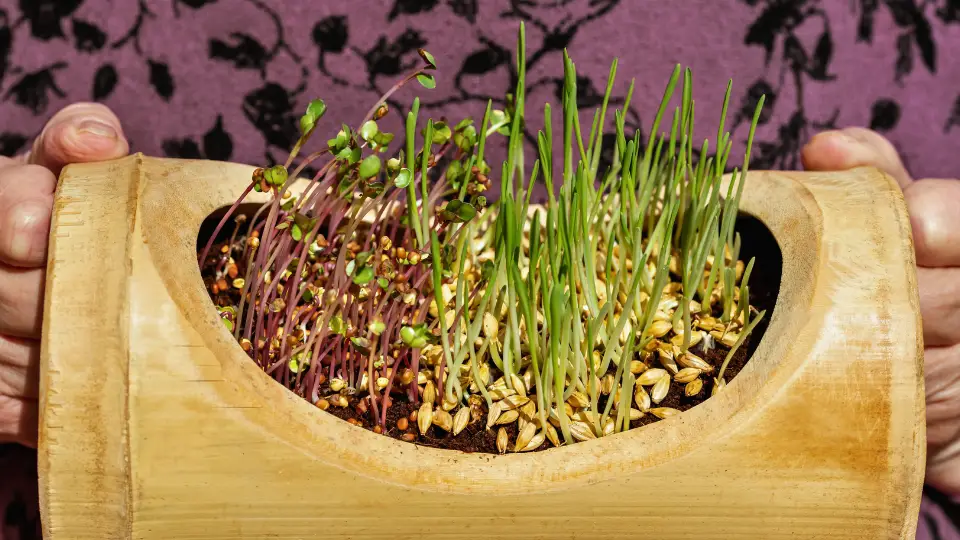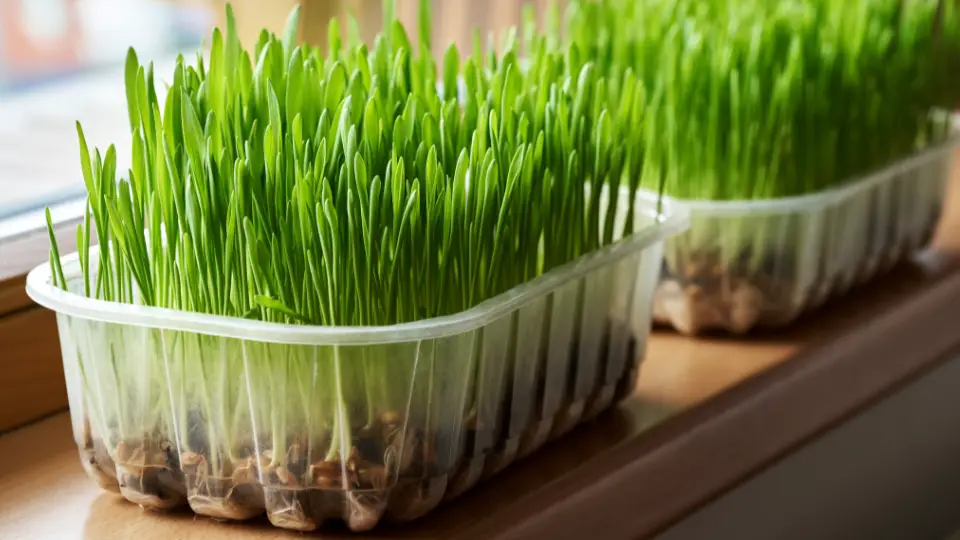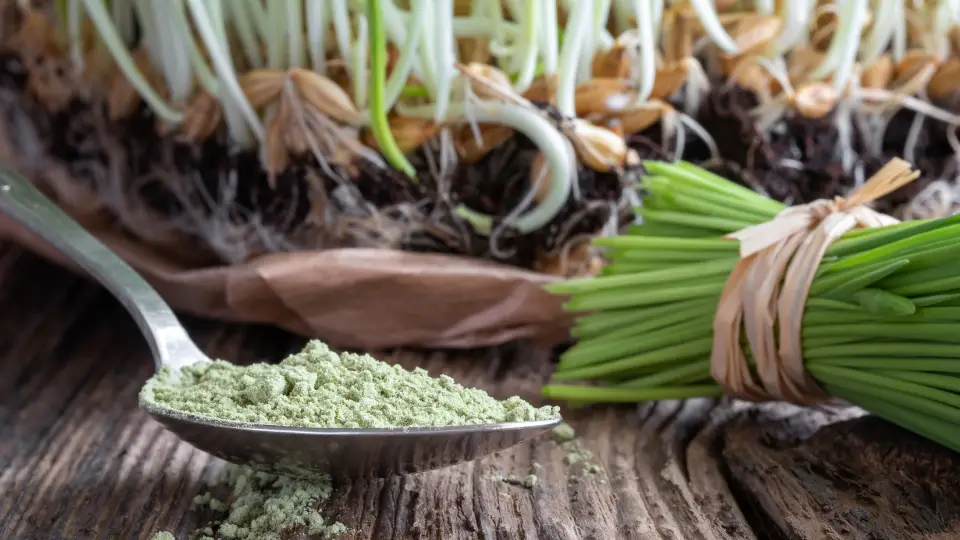
Barley Microgreens: Boost Your Health Powerhouse
Barley microgreens are a nutrient-rich and easy-to-grow type of microgreen that offers various health benefits. They are packed with vitamins, minerals, and antioxidants, making them a great addition to salads, sandwiches, and smoothies.
These small but powerful greens have a delicate yet distinctive flavor profile, similar to fresh barley grass. Barley microgreens also contain chlorophyll, which helps to oxygenate the blood and detoxify the body. With their vibrant green color and tender texture, these microgreens are delicious and add visual appeal to any dish.
Whether you are a health enthusiast or just looking to add more nutrients to your diet, barley microgreens are a simple and effective way to boost your overall well-being.
Nutritional Benefits Of Barley Microgreens
Barley microgreens may be small in size, but they pack a powerful punch when it comes to nutritional benefits. These tiny greens are tasty, visually appealing, and nutritional powerhouses.
They are loaded with vitamins, minerals, and antioxidants, making them a great addition to your diet. This section will explore the various nutritional benefits of barley microgreens.

Rich In Vitamins And Minerals
Barley microgreens are a rich source of vitamins and minerals, making them an excellent choice for boosting nutrient intake. These greens are exceptionally high in vitamins C, K, and iron. Vitamin C is essential for boosting the immune system and promoting overall health.
Vitamin K plays a crucial role in blood clotting and bone health. Iron is vital for red blood cell production and oxygen transportation throughout the body.
High In Antioxidants
Antioxidants protect our cells from the damage caused by free radicals. Barley microgreens are packed with antioxidants, making them an excellent choice for promoting overall health and well-being.
These greens are particularly high in flavonoids, plant compounds with potent antioxidant properties. Flavonoids help reduce inflammation, lower the risk of chronic diseases, and may even have anti-cancer properties.
Good Source Of Fiber
Barley microgreens are a healthy fiber source, essential for maintaining a healthy digestive system. Fiber helps promote regular bowel movements, prevents constipation, and aids in weight management.
Barley microgreens are exceptionally high in soluble fiber, which reduces cholesterol levels and improves heart health. By including these greens in your diet, you can ensure you get the fiber your body needs to function correctly.
Health Benefits Of Barley Microgreens
Regarding superfoods, barley microgreens are taking the health world by storm. These tiny greens, packed with incredible nutrients, offer various health benefits that can boost your well-being in various ways.
Throughout this article, we’ll explore the health benefits of barley microgreens, including their ability to boost the immune system, support healthy digestion, and promote cardiovascular health.
Boosts Immune System
Barley microgreens are a powerhouse of immune-boosting properties. They are rich in antioxidants, vitamins, and minerals that strengthen the immune system, helping you fight off infections and diseases.
The abundance of vitamin C in barley microgreens promotes a robust immune response, while beta-glucans enhance immune cells’ activity.

Supports Healthy Digestion
A healthy digestive system is crucial for overall well-being, and barley microgreens can help you achieve it. These microgreens are an excellent source of dietary fiber, which aids digestion and prevents constipation.
Additionally, the enzymes present in barley microgreens promote the breakdown of complex nutrients, making it easier for your body to absorb and utilize them efficiently.
Promotes Cardiovascular Health
Your heart is your body’s powerhouse, and caring for it is essential. Barley microgreens can promote cardiovascular health due to their high fiber content and low cholesterol levels.
The dietary fiber in these microgreens regulates cholesterol levels, reducing heart disease risk. Furthermore, essential minerals such as potassium and magnesium support healthy blood pressure levels, preventing hypertension.
How To Grow Barley Microgreens
Growing your barley microgreens is an excellent way to add freshness and nutritional value to your meals. They are easy to grow and require minimal space, making them perfect for apartment dwellers and anyone with limited gardening space.

To enjoy barley microgreens right at home, we will walk you through a step-by-step guide to growing them.
Choosing The Right Seeds
When it comes to growing barley microgreens, selecting high-quality seeds is crucial. Ensure that you choose organic barley seeds specifically meant for microgreen cultivation. These seeds have a high germination rate and are free from chemical treatments or pesticides that can harm your health.

Preparing The Soil Or Growing Medium
The next step in growing barley microgreens is to prepare the soil or growing medium. You can opt for soil-based or soilless growing mediums.
If you choose soil, ensure it is well-drained and has a balanced moisture retention capacity. On the other hand, soilless mediums like coco coir or hemp mats can also be used. These mediums are lightweight sterile, and allow for excellent root growth.
If you prefer a soilless growing medium, follow these simple steps:
- Moisten the coco coir or hemp mat by soaking it in water for a few minutes.
- Place the moistened medium in a tray or container, ensuring it is evenly spread.
- Press it gently to ensure good contact with the tray or container.
Planting And Caring For The Microgreens
Now that your growing medium is ready, it’s time to plant and care for the barley microgreens:
- Spread the pre-soaked barley seeds evenly over the growing medium, ensuring good coverage.
- Press the seeds into the medium using a flat object or your hand.
- Water the seeds using a fine mist spray bottle or a watering can with a fine rose attachment.
- Place the tray or container away from direct sunlight in a warm and well-lit area.
- Keep the growing medium slightly moist throughout the germination and growth period.
- Avoid over-watering to prevent mold or fungal growth. Remember, barley microgreens prefer well-drained soil.
- Provide airflow by using a small fan or periodically opening a window to prevent stagnant air and promote healthy growth.
Harvesting And Storing The Microgreens
After around 7 to 14 days, your barley microgreens will be ready to harvest. Look for the emergence of the first set of true leaves, indicating their maturity. To harvest, follow these steps:
- Gently hold the base of the microgreens and snip them off using a clean pair of scissors or a sharp knife.
- Collect the harvested microgreens in a clean container or cutting board.
- Rinse them gently under cool running water to remove soil or growing medium residue.
- Allow the microgreens to air-dry or gently pat them dry with a clean paper towel.
It is best to consume the harvested barley microgreens immediately for optimal freshness. If you need to store them, place them in an airtight container lined with a paper towel and refrigerate for up to 5 days.
Incorporating Barley Microgreens Into Your Diet
Barley microgreens are nutritional powerhouses packed with vitamins, minerals, and antioxidants. These tiny greens add flavor to your dishes and provide health benefits. Here are some creative ways to incorporate barley microgreens into your diet:
Adding To Salads And Sandwiches
Barley microgreens make a delightful addition to salads and sandwiches, giving them an extra burst of freshness and crunch. Toss a handful of these nutritious greens into your favorite salad mix or use them as a topping for your sandwiches. Their delicate yet vibrant taste will elevate the flavors of your dishes.
Blending Into Smoothies
If you’re a smoothie fan, why not amp up their nutritional value by adding barley microgreens? These greens blend seamlessly into your favorite fruit or vegetable smoothies, providing an extra boost of vitamins and minerals. Give your morning smoothie a healthy twist by incorporating barley microgreens.

Using As A Garnish
If you’re a smoothie fan, why not amp up nutritional value by adding barley microgreens?
These greens blend seamlessly into your favorite fruit or vegetable smoothies, providing an extra boost of vitamins and minerals. Give your morning smoothie a healthy twist by incorporating barley microgreens.
Incorporating Into Cooked Dishes
Don’t limit the use of barley microgreens to raw preparations. These greens can also be incorporated into cooked dishes without losing nutritional value.
Add them to stir-fries, scrambled eggs, or sautéed vegetables to infuse your meals with a hint of freshness and subtle nutty flavor. Cooking barley microgreens releases their nutrients, making them an excellent addition to your dishes.
Tips For Buying And Storing Barley Microgreens
Learn essential tips for buying and storing barley microgreens to ensure freshness and quality. Discover how to choose the best barley microgreens and properly store them for maximum flavor and longevity.

Choosing Fresh And Healthy Microgreens
When purchasing barley microgreens, it’s important to choose ones that are fresh and healthy. Here are a few tips to help you select the best microgreens for your needs:
- Inspect the leaves: Look for vibrant, green leaves without any signs of wilting or discoloration.
- Check for mold or rot: Avoid microgreens with any visible signs of mold or rot, as this indicates poor quality or improper storage.
- Fragrance matters: Give the microgreens a gentle sniff to ensure they have a fresh, pleasant fragrance. Avoid any musty or unpleasant odors.
- Choose smaller sizes: Smaller microgreens tend to have a more concentrated flavor and are often more tender and enjoyable to eat.
Properly Storing And Preserving Microgreens
Once you’ve purchased your barley microgreens, storing and preserving them properly is crucial to maintain their freshness and flavor. Follow these tips for optimal storage:
- Rinse and dry: Gently rinse the microgreens with cool water and dry them with a paper towel before storing them.
- Use airtight containers: Transfer the microgreens to a clean, airtight container or resealable bag. This helps to keep them fresh and prevents moisture and odors from affecting their quality.
- Refrigerate at the right temperature: Place the container in the refrigerator and set the temperature between 35 to 40 degrees Fahrenheit (2 to 4 degrees Celsius). This helps to slow down the degradation process and maintain their freshness.
- Consume within a week: While microgreens can last longer, consuming them within a week is recommended to enjoy the best flavor and texture.
Safety Precautions And Potential Risks
When growing and consuming barley microgreens, it’s necessary to prioritize safety precautions and know potential risks.
You can enjoy these nutritious greens without any concerns by following hygienic practices, avoiding contamination, and identifying allergic reactions or sensitivities.
Ensuring Hygienic Growing Conditions
Growing barley microgreens in a clean and hygienic environment is crucial for ensuring the safety of your harvest. Here are some key steps to take:
- Wash and sterilize: Before planting the seeds, thoroughly wash your trays, containers, and other growing equipment with warm, soapy water. Rinse them well and consider sterilizing them by wiping them with diluted bleach or using a natural disinfectant like vinegar.
- Quality seeds: Using high-quality organic seeds from a reputable source reduces the risk of contamination and promotes healthier growth.
- Filtered water: Use clean, filtered water to hydrate your microgreens. This helps prevent exposure to harmful bacteria and impurities that might be present in tap water.
Avoiding Contamination
To keep your barley microgreens safe from contamination, here’s what you need to keep in mind:
- Proper handling: Always wash your hands thoroughly before and during cultivation to minimize the transfer of bacteria and other pathogens to the greens.
- Sanitize tools: Regularly disinfect your gardening tools and equipment to prevent the buildup and spread of harmful bacteria or mold.
- Watch for pests: Keep a close eye on your barley microgreens for any signs of pest infestation. If you notice pests, immediately use natural methods or organic pest control measures.
- Storage: Store your microgreens properly in airtight containers in the refrigerator after harvesting. This prevents cross-contamination and maintains their freshness for longer.
Identifying Allergic Reactions Or Sensitivities
While barley microgreens are generally safe to consume, it’s important to be aware of potential allergic reactions or sensitivities. Here’s what you should know:
- Introduce gradually: When incorporating barley microgreens into your diet for the first time, start with small servings to gauge your body’s reaction.
- Monitor symptoms: Pay attention to unexpected symptoms such as itching, redness, swelling, or difficulty breathing after consuming microgreens. If these symptoms occur, discontinue use and consult a medical professional.
- Allergies: Individuals with known allergies to grains or grasses may have a higher risk of developing allergies or sensitivities to barley microgreens. Such individuals should consult their healthcare provider before including them in their diet.
By following these safety precautions and being mindful of potential risks, you can confidently enjoy the nutritional benefits of barley microgreens while minimizing any adverse effects.
Frequently Asked Questions Of Barley Microgreens
Can You Eat Barley Microgreens?
Yes, barley microgreens can be eaten. They are nutritious and packed with vitamins and minerals. Enjoy them in salads, sandwiches, or as a garnish for your favorite dishes. They add a fresh and flavorful crunch to your meals.
Can Humans Eat Barley Sprouts?
Yes, humans can eat barley sprouts. They are nutritious, rich in vitamins and minerals, and can be added to salads, sandwiches, or smoothies. Barley sprouts are also commonly used in soups, stews, and topping dishes like Buddha bowls.
What Are The Benefits Of Barley Sprout?
Barley sprouts offer numerous benefits, including high nutrient content, enhanced digestion, boosted immunity, and improved heart health. They are rich in vitamins, minerals, and fiber, promoting overall well-being and helping to prevent chronic diseases. Incorporating barley sprouts into your diet can be a valuable addition to a healthy lifestyle.
Conclusion
Consider incorporating barley microgreens into your diet to reap the benefits of these nutrient-rich superfoods. Bursting with vitamins, minerals, and antioxidants, these tiny greens pack a powerful punch. Whether added to salads and smoothies or used as a garnish, barley microgreens offer a delicious and nutritious addition to any meal.
Explore this versatile ingredient and elevate your health and well-being with the incredible benefits of barley microgreens. Embrace this natural source of goodness and fuel your body with its unique properties.
Video Sorce: https://www.youtube.com/watch?v=8A0fUXW56Eo



